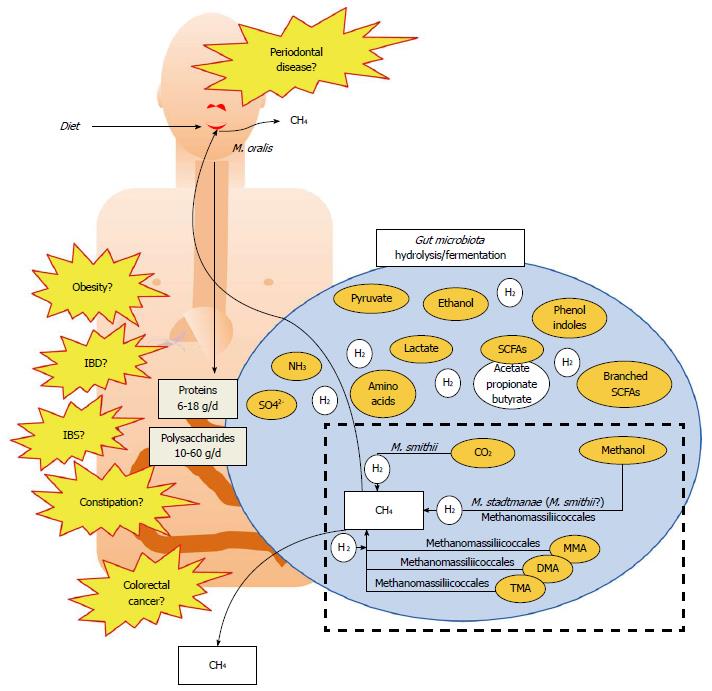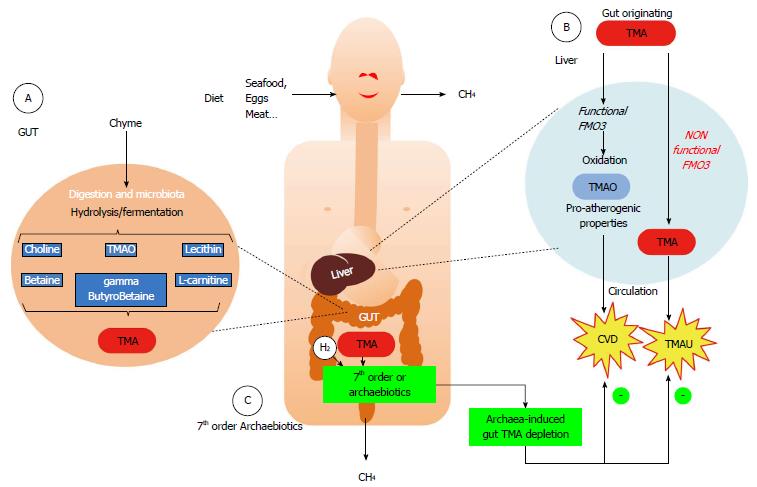Copyright
©2014 Baishideng Publishing Group Inc.
World J Gastroenterol. Nov 21, 2014; 20(43): 16062-16078
Published online Nov 21, 2014. doi: 10.3748/wjg.v20.i43.16062
Published online Nov 21, 2014. doi: 10.3748/wjg.v20.i43.16062
Figure 1 Archaeal representatives associated to the human digestive tract.
A simplified phylogeny of the Archaea (adapted from[89,148]) is shown. Taxonomic orders are drawn in filled square boxes, those composed of methanogens in yellow and others in light grey. Orders in which some members have been found in the human digestive tract are indicated in light blue boxes when identified by sequences derived from nested-PCR (or deep sequencing on low yield amplifications for Nitrososphaera spp.) or a limited number of studies, and other are indicated in dark blue boxes in which abundant and recurrently reported species are mentioned in orange boxes or light blue when observed from limited number of studies. For the Methanomassiliicoccales (1), also referred as Methanoplasmatales in the literature, the repartition of Methanomassiliicoccus spp. and Ca. Methanomethylophilus spp. in two different clades is highlighted by yellow branches (see the text for details).
Figure 2 Simplified representation of the role of methanogens in the gut microbiota metabolism and possible association with diseases.
Diet leads to proteins and polysaccharides that enter the gut where they are metabolized by the hydrolytic and fermentative bacteria present in the gut (large blue circle). This produces various compounds (some important being indicated in orange circles), and large amounts of H2, which in turn inhibit the fermentation processes. H2 partial pressure is lowered by hydrogenotrophs, three different types being present in the gut (sulfate-reducing bacteria, acetogens and methanogens). Here, only the methanogens are shown, which are either able to use CO2, methanol, or methyl-compounds [monomethylamine (MMA); dimethylamine (DMA) and trimethylamine (TMA)] reduced by hydrogen to form methane, found in breath and flatulence. A highlight on the TMA use is given in Figure 3. The presence of methanogens in the mouth is also indicated. Altogether, the presence of methanogens has been linked to several diseases (in yellow) but these remains to be clarified (see Table 2 for further explanations).
Figure 3 Faith of trimethylamine originating from the gut microbiota metabolism and putative role of representatives of Methanomassiliicoccales.
A: Several common foods (containing lecithin/choline, L-carnitine, trimethylamine oxide,…) are metabolized into trimethylamine (TMA) by some bacterial components of the microbiota; B: When the microbiota does not contain any members of the 7th order of methanogens, the gut-originating TMA reaches the liver, where it is oxidized by the flavin-monoxygenase FMO3 into trimethylamine oxide (TMAO) (Blue arrows in B). This odorless molecule has recently been shown to be associated to cardiovascular diseases (CVD) and has pro-atherogenic properties. In some people however, with a deficiency in liver oxidation, the TMA is not or less metabolized (orange arrows in B) and reaches various body fluids, leading to trimethylaminuria (TMAU) or “fish-odor syndrome”; C: When present, either naturally or by supplementation (Archaebiotics), it is hypothesized that members of the 7th order of methanogens, through their up to now unique metabolism in the gut, might decrease the concentration of TMA by converting it into methane, therefore leading to an archaea-mediated TMA depletion before it can reach the liver. This could therefore be a convenient way to prevent CVD or limit TMAU.
- Citation: Gaci N, Borrel G, Tottey W, O’Toole PW, Brugère JF. Archaea and the human gut: New beginning of an old story. World J Gastroenterol 2014; 20(43): 16062-16078
- URL: https://www.wjgnet.com/1007-9327/full/v20/i43/16062.htm
- DOI: https://dx.doi.org/10.3748/wjg.v20.i43.16062











